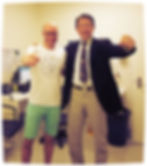My Handshake
- Paul Fink
- Dec 23, 2017
- 3 min read

“A handshake is a short ritual in which two people grasp one of each other's like hands.... Using the right hand is generally considered proper etiquette [Especially the western countries]”
Prior to my stroke, I was very accustomed to greeted someone. It depends on the individual person who is initiating a greeting and a situation. Eg. Friends or family members, I sometimes will kiss or hug (or manhug), but meet new people, former business colleagues or playing team sports, I normally will shaking hands.
I am almost four years post-stroke now, I have right side paralysis still, and my right hand is improving - but it is compromised. And I have spasticity with my hand. Luckily, I can move my right hand up-and-down and I have a little bit of feeling but it’s nowhere near functional yet.
After my stroke happened, I was frustrated because I was not able to make a handshake. I was able to a awkwardly fist-bump only - and I lost little bit my ‘manliness’. Saying that, Usain Bolt is a big fan of the fist-bump :).

I know handshakes are not a big deal - in general - especially my therapists, friends, family and acquaintances knows my situation [with my disability] - but my self-esteem was dented somewhat, because my long-time goal was to be ‘normal’ as possible. This goal included greeting people, and I was conscious of the other people’s response to my handshake also.
In the hospital (and rehab), I remember my therapists and Lauren discussing Botox (Botulinum toxin). Previously, I had heard about Botox with wrinkles but I was thinking ‘Botox with me?? And why?? I am not old... and I imagined the skit of Sam Newman at the AFL Footy Show. I found that after that very common with stroke patients in fact, nearly one out of every three patients may have spasticity after a stroke - but it is most common in the arm. Essentially, Botox to reduce spasticity so patients can participate in therapy that leads to recovery... Therefore I received Botox injections with my hand, and I think definitely helped my acceleration of hand therapy.

After my discharged - roughly eight months after my stroke - I saw my neurosurgeon Professor Peter Hwang (pictured below) for the follow-up appointment at the Alfred Hospital. He was impressed with my progress and after the appointment finished, I reached my left hand trying to Peter’s hands on the purpose of the thanks for saved my life - after all this man is a hero - but he refused to shake my left hand. At the same motion, he instructed to shaking hands my [affected] right hand instead. Not much said after the gesture, but I knew what to do.
After roughly two years, and lots of OT therapy, more swim and gym sessions and more Botox, I am able to do a handshake with my right arm. I know I have of work to do to be a expert, but handshaking my friends, family or even strangers is an amazing feeling.
That’s why I always shaking hands with my right hand now. Other people possibly are awkward my handshake, or sometimes politely initiating a handshake with my left hand, but I honestly I don’t care. Peter’s handshake gave me self-confidence to be not embarrassed of my handshake and appearance and I was empowered by it. After all, every handshake is a little bit of therapy anyway.... and I need lots of therapy to be improving.







